Tennant Creek
Tennant Creek (Warumungu: Jurnkkurakurr) is a town located in the Northern Territory of Australia. It is the seventh largest town in the Northern Territory, and is located on the Stuart Highway, just south of the intersection with the western terminus of the Barkly Highway. At the 2016 census, Tennant Creek had a population of approximately 3,000, of which over 50% (1,536) identified themselves as indigenous.[1]
| Tennant Creek Northern Territory | |||||||||
|---|---|---|---|---|---|---|---|---|---|
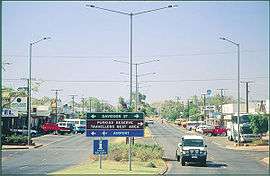 Main Street, Tennant Creek | |||||||||
 Tennant Creek | |||||||||
| Coordinates | 19°38′50″S 134°11′25″E | ||||||||
| Population | 2,991 (2016 census)[1] | ||||||||
| Established | 3 June 1954 (town)[2] | ||||||||
| Postcode(s) | 0860 | ||||||||
| Time zone | ACST (UTC+9:30) | ||||||||
| Location |
| ||||||||
| LGA(s) | Barkly Region | ||||||||
| Territory electorate(s) | Barkly | ||||||||
| Federal Division(s) | Lingiari | ||||||||
| |||||||||
The town is approximately 1,000 kilometres south of the territory capital, Darwin, and 500 kilometres north of Alice Springs. It is named after a nearby watercourse of the same name, and is the hub of the sprawling Barkly Tableland vast elevated plains of black soil with golden Mitchell grass, that cover more than 240,000 square kilometres. Tennant Creek is also near well-known attractions including the Devils Marbles, Mary Ann Dam, Battery Hill Mining Centre and the Nyinkka Nyunyu Culture Centre
The Barkly Tableland runs east from Tennant Creek towards the Queensland border and is among the most important cattle grazing areas in the Northern Territory. Roughly the same size as the United Kingdom or New Zealand, the region consists largely of open grass plains and some of the world's largest cattle stations. It runs as far south as Barrow Creek, north above Elliott and west into the Tanami Desert.
The region encompasses the junction of two great highways, the Barkly and the Stuart, also known as the Overlander and Explorer's Ways. The Overlander's Way (Barkly Highway) retraces the original route of early stockmen who drove their cattle from Queensland through the grazing lands in the Northern Territory.
Geography and climate
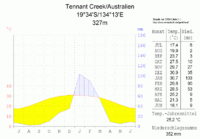
Tennant Creek is located in the middle of the Northern Territory, 376.5 metres above sea level. Average maximum temperatures range from 24 degrees to 38 degrees, with an average of 22 days per year exceeding 40 degrees. Minimum temperatures range from 12 degrees in winter to 25 degrees in the hotter months.
Tennant Creek gets 181.0 clear days annually.
Most of the rain falls during the summer months, but occasional storms occur at other times of the year. Average annual rainfall is 473mm. The dry season (May to October) in Tennant Creek is relatively sunny with cool nights and mornings. The wet season (November to April) is hot and humid with occasional rainfall.[3]
| Climate data for Tennant Creek (1969-2016) | |||||||||||||
|---|---|---|---|---|---|---|---|---|---|---|---|---|---|
| Month | Jan | Feb | Mar | Apr | May | Jun | Jul | Aug | Sep | Oct | Nov | Dec | Year |
| Record high °C (°F) | 45.6 (114.1) |
44.5 (112.1) |
42.0 (107.6) |
38.4 (101.1) |
36.8 (98.2) |
33.6 (92.5) |
34.7 (94.5) |
36.0 (96.8) |
39.0 (102.2) |
41.6 (106.9) |
43.4 (110.1) |
45.4 (113.7) |
45.6 (114.1) |
| Average high °C (°F) | 36.7 (98.1) |
35.7 (96.3) |
34.4 (93.9) |
31.7 (89.1) |
27.7 (81.9) |
24.5 (76.1) |
24.6 (76.3) |
27.5 (81.5) |
31.7 (89.1) |
34.9 (94.8) |
36.5 (97.7) |
37.1 (98.8) |
31.9 (89.5) |
| Average low °C (°F) | 24.9 (76.8) |
24.4 (75.9) |
23.3 (73.9) |
20.4 (68.7) |
16.4 (61.5) |
12.9 (55.2) |
12.3 (54.1) |
14.4 (57.9) |
18.4 (65.1) |
21.8 (71.2) |
23.9 (75.0) |
24.8 (76.6) |
19.8 (67.7) |
| Record low °C (°F) | 17.2 (63.0) |
17.2 (63.0) |
14.6 (58.3) |
11.6 (52.9) |
6.7 (44.1) |
5.3 (41.5) |
4.5 (40.1) |
6.0 (42.8) |
7.4 (45.3) |
11.6 (52.9) |
10.7 (51.3) |
15.7 (60.3) |
4.5 (40.1) |
| Average precipitation mm (inches) | 114.3 (4.50) |
122.6 (4.83) |
54.2 (2.13) |
17.0 (0.67) |
8.5 (0.33) |
5.7 (0.22) |
5.0 (0.20) |
2.5 (0.10) |
7.8 (0.31) |
19.5 (0.77) |
40.9 (1.61) |
74.6 (2.94) |
475.0 (18.70) |
| Average precipitation days | 9.9 | 9.3 | 6.0 | 2.0 | 1.6 | 0.9 | 0.7 | 0.7 | 1.9 | 3.7 | 5.7 | 8.1 | 50.5 |
| Average relative humidity (%) | 32 | 35 | 29 | 26 | 26 | 26 | 22 | 18 | 17 | 18 | 21 | 26 | 25 |
| Mean daily sunshine hours | 9.2 | 9.0 | 9.2 | 9.8 | 9.7 | 9.9 | 10.2 | 10.6 | 10.2 | 10.1 | 9.7 | 9.5 | 9.8 |
| Source: [4] | |||||||||||||
Topography and climate
Although Tennant Creek has a warm desert climate (Köppen Classification BWh),[5] it still receives a sizeable 475 mm (18.2 in) of annual precipitation.[6] It also has distinct wet and dry seasons. Most rain falls during the period from December to March, when temperatures are also at their highest. Temperatures fall during the dry months with sunny days and mild nights. There is 9.1 to 10.4 hours of sunshine per day with an average of 155 clear days per year. Prevailing winds are from the east to south-east.
Built environment
Tennant Creek has developed from its rough, tough droving and gold mining days into a modern town with shops and a supermarket, accommodation, bars, clubs and restaurants, a regional hospital, schools and banking facilities.
Parks and gardens
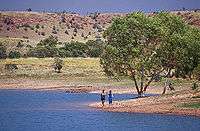
Mary Ann Dam is a popular recreation spot, easily accessible from town by road or bicycle track and popular for swimming, barbecues, picnics or bush walks. The area's best known attraction, Karlu Karlu / Devils Marbles Conservation Reserve is 100 kilometres south of Tennant Creek and is one of the Territory's most photographed features. These huge granite boulders are scattered through a wide, shallow valley. The formations provide shelter to a variety of flora and fauna of the area and glow a rich red in the light of the early evening. Local Aboriginal mythology holds that the boulders are the eggs of the Rainbow Serpent. Visitors can take a self-guided walk from the car park. Bush camping facilities are available.
Another popular spot close to Tennant Creek is the Iytwelepenty / Davenport Ranges National Park, best explored by four-wheel-drive vehicle.
History
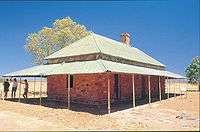

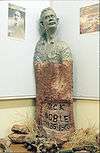
The Warumungu people have lived in the region surrounding Tennant Creek for thousands of years. The traditional name for the creek north of where is now located is Jurnkkurakurr, although it is now used to refer to the area of the township as well.[7] The first European explorer to pass through the region was John McDouall Stuart in 1860, on his unsuccessful first attempt to cross the continent from South to North. He named a creek to the north of town after John Tennant, a financier of his expedition and a pastoralist from Port Lincoln, South Australia, in gratitude for the financial help Tennant had provided for Stuart's expeditions across Australia.
The Overland Telegraph that once linked Melbourne to London was constructed in the 1870s and forged a corridor through the middle of the continent that the Explorer's Way and Ghan train now travel. A temporary building for a telegraph repeater station was erected near the watercourse of Tennant Creek in 1872. Two years later, the solid stone buildings of the Tennant Creek Telegraph Station that remain on the site today, were completed by the occupants of the station. This is one of the four remaining original telegraph stations in Australia. Tennant Creek was the site of Australia's last gold rush during the 1930s and at that time was the third-largest gold producer in Australia. The Tennant Creek Telegraph Station remained an isolated outpost until that time.
Gold was discovered in the ranges three miles north of the current town area in 1926 by J Smith Roberts[8] In 1927 Charles Windley, a telegraph operator, found gold on what would become Tennant Creek's first mine, The Great Northern.[9] Australia's last great Gold Rush did not commence, however, until after Frank Juppurla, a local Indigenous man, took gold to telegraph operator Woody Woodruffe in December 1932. The population quickly grew to about 600, 60 of whom were women and children.[10] "Battery Hill" which overlooks the town of Tennant Creek is the site of one of the last two operating ten-head stamp batteries, a Government owned ore crushing machine.
The town of Tennant Creek was located 12 km south of the watercourse because the Overland Telegraph Station had been allocated an 11 km reserve. Local legend offers a different explanation for the town's location. In 1934 Joe Kilgarriff from Alice Springs built the Tennant Creek hotel on the eastern side of the telegraph line, the building supplies being delivered on the first commercial journey of the AEC Roadtrain from Alice Springs. The pub still exists and is a historic monument to the early days.
Cecil Armstrong was one man who made a contribution to the early development of Tennant Creek. He arrived in April 1935 and began baking bread the next day. In 1937 he built Armstrong's bakery and cafe where he lived and worked for over twenty years as baker and cafe proprietor. The building still stands today, albeit under a different guise. Cecil's telephone number was simply the number 1 and his Post Office box was also number 1.
Another important contributor to Tennant life was Mrs Weaber, wife of the blind owner of the Rising Sun Mine, one the richest gold mines in the district before World War II. A devout Catholic, Mrs Weaber paid for the old church at Pine Creek to be transported to Tennant Creek plank by wooden plank, thereby establishing the Tennant Creek Catholic Church. Mrs Weaber also started the Tennant Creek Christmas tree event when, in the early 1930s she held a party at her husband's gold mine and gave every child on the gold field a present. Mrs Weaber's generosity continues into the present day. Every year the town erects a public Christmas tree and every child, local or visitor, is given a present. The Weaber family left Tennant Creek in 1940 following a series of personal family tragedies. They sold the lease to what would become Tennant's richest post war mine, Nobles Nob, before they realised its potential.[11] Nobles Nob was named after Jack Noble, an old friend of the Weaber family from the days when they all lived in the Kimberley Region of Western Australia.
Gold Mining was all but shut down in Tennant Creek in 1942. The only mine to remain operational was a large mine with its own crushing plant.[12] During World War II, the Australian Army set up 55th Australian Camp Hospital near Tennant Creek. The Royal Australian Air Force utilised Tennant Creek Airfield as an emergency landing ground.
The town today is situated on a stretch of the Stuart Highway known as Paterson Street. As it is a regional centre, it contains government services and local business and also has a developing tourist centre. There are a number of restaurants and tourist activities to complement its friendly relaxed lifestyle. The people of Tennant Creek enjoy modern facilities including reserves, sporting venues, galleries, a civic hall and library. It's also home to Australia's premier go-karting event, held on a street circuit through the town.
Demographics
The total population of Tennant Creek is approximately 3,000, of which around 1,500 are Aboriginal. Tennant Creek is an ethnically diverse town, with residents from Britain, New Zealand, Ireland, the Philippines, Thailand, India, Bosnia and Germany as well as Australia.
Government
Tennant Creek had a town council headed by a mayor until 1 July 2008, when it became part of the Barkly Region.
The main Aboriginal body within the town is the Julalikari Council Aboriginal Corporation which plays a major role in providing training and employment services for the Aboriginal people in Tennant Creek. It has developed a construction capacity and provides contract services to the Town Council such as recycling. Julalikari also provides community services within the township such as Homemakers, aged care, and the night patrol.
The police district covers almost 22,000 square kilometres and has a strength of 25 officers. The force includes two Criminal Investigation Branch (CIB) officers.
Economy
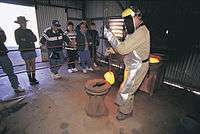
Mining
Tennant Creek was once the third largest gold producer in Australia and is still highly productive. Over 210 tonnes of gold have been mined in the area. Notable mines include, Nobles Nob mine and the Peko mine. The Bootu Mine to the north of town exports manganese to China. Major mining companies are continuing to explore for bauxite, lead-zinc-silver and copper around the area. Exploration has commenced to the southeast of town for unspecified minerals. Tennant Creek is also the centre of the rich pastoral industry of central Australia, with vast cattle properties stocked with herds of Santa Gertrudis and Brahman cattle.
Phosphate deposits exist at Wonarah, 250 km to the east.[13]
Tourism
Tourism is a growing industry emphasising its location, history, scenery and cultural attributes and provides tourists with an opportunity to experience the outback. The mineral collection at Battery Hill is a must-see, although the stamp battery ceased working in 2005, but has since been refurbished and now operates daily for tours. The exhibition 'Freedom, Fortitude and Flies' in the social history museum at Battery Hill tells the story of mining in Tennant through the eyes of women and children. It was designed by award-winning artist Alison Alder, a former Tennant Creek resident.
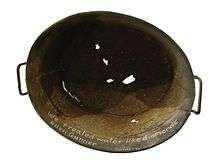
Aboriginal enterprise and organisations generate economic activity for Tennant Creek by providing a range of services to the urban and rural communities of the town.
Nyinkka Nyunyu Arts and Cultural Centre opened in July 2003, offering visitors and the community an opportunity to learn about Aboriginal life, history and culture.
Transport
.jpg)
Tennant Creek has been accessible by train since the completion of the Adelaide-Darwin railway north from Alice Springs in 2004. The Ghan, run by Great Southern Rail between Adelaide and Darwin passes twice weekly in each direction.[14]
Tennant Creek is serviced by Tennant Creek Airport. Charter flights can be organised from Darwin or Alice Springs to Tennant Creek. Outback Airlines currently service Tennant Creek, providing mining charters between Alice Springs and Tennant Creek with seats available to the general public.
Tennant Creek has daily coach bus service from Darwin, Alice Springs, and Queensland. The Barkly Tablelands are best explored via Tennant Creek, which can be accessed on the fully sealed Explorer's Way, 1,000 kilometres south of Darwin, 670 kilometres south of Katherine and 510 kilometres north of Alice Springs. The Overlander's Way (Barkly Highway) is another tourism drive from Queensland that meets the Explorer's Way at Threeways – 25 kilometres north of Tennant Creek.
In May 2005, Minemakers and ATEC signed an agreement to study a 250 km open access railway from Tennant Creek to Wonarah.[15]
Historically, there has been suggestion of a rail link between Tennant Creek and Mount Isa.[16] This link would allow resources companies to gain access to both the Adelaide-Darwin (The Ghan) and Townsville-Mount Isa (The Inlander) lines. The missing rail link would also provide rail passengers with direct rail access to Darwin from the East Coast of Australia. The Australian Defence Force may also use the link to provide a rail access between the 1st Brigade in Darwin, and the 3rd Brigade in Townsville.
Education
Tennant Creek has a primary and high school. In the 1970s and 80s, secondary students tended to leave Tennant Creek and board at secondary schools in Darwin and Alice Springs, but today young people prefer to remain at schools in Tennant Creek.
Society and culture
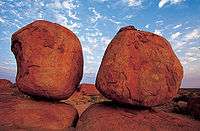
Aboriginal people have lived in the Barkly region for over 40,000 years. The Barkly region is steeped in the ancient traditions and beliefs of its traditional custodians and around nine Aboriginal groups, including the Warumungu, Warlpiri, Kaytetye and Alyawarre people call the area home. Tennant Creek is an important social, cultural and business centre for many Aboriginal people of various language groups.
Leisure and entertainment
The Northern Territory holds several regional events throughout the year, which in some cases can impact on visitor numbers to the region. Events located within the Barkly Area during the year include the Desert Harmony Festival, the Barkly Campdraft and Rodeo, Saint Patrick's Day Races, Barkly May Day Muster and the Brunette Downs Races. The World Solar Car Challenge takes place every second year.[17]
Music and Art
Tennant Creek has a rich and colourful musical community, and the Winanjjikari Music Centre is home to a number of emerging singers, songwriters and musicians. In 2003 the award-winning Nyinkka Nyunyu Cultural Centre was opened, a purpose-built centre, planned and designed in close consultation with local Aboriginal people. The centre houses exhibitions on local history from an Aboriginal point of view, cultural displays and local artwork. It is considered one of the best of its kind in the Northern Territory, beautifully presented and maintained by the local people.
Sport
There are a number of sports and recreation clubs in Tennant Creek for locals.
Violence and Sexual Assault
Over the past few years the rising number of child rape, alcohol abuse, domestic violence and family disputes between locals despite such a small population has been raised by numerous media sources and identified as a region of legitimate concern in comparison to other states and isolated townships.[18][19]
See also
References
- Australian Bureau of Statistics (27 June 2017). "Tennant Creek (Urban Centre)". 2016 Census QuickStats. Retrieved 18 December 2017.

- "NORTHERN TERRITORY OF AUSTRALIA (Proclamation of the Town of Tennant Creek)". Commonwealth of Australia Gazette (35). Australia, Australia. 3 June 1954. p. 1603. Retrieved 25 April 2019 – via National Library of Australia.
- Tennant Creek' Climate Archived 6 April 2007 at the Wayback Machine
- "Climate statistics for Tennant Creek".
- "World Map of Köppen-Geiger Climate Classification" (PDF). University of Veterinary Medicine Vienna. Archived from the original (PDF) on 14 January 2009. Retrieved 30 December 2008.
- "Climate Statistics for Australian Locations". Australian Bureau of Meteorology. Retrieved 30 December 2008.
- Jane Simpson, A learner's guide to Warumungu, retrieved 2 December 2018
- McKeon, MR, (consulting engineer) 'Tennant Creek Goldfield' in Chemical Engineering and Mining Review, 10 August 1940.
- Pearce, Howard, Tennant Creek Historic Sites Study: A Report to the National Trust of Australia, Northern Territory Volume 2, December 1984.
- Kelham, Megg (2007). "Discovering Local History at the Battery Hill Mining Centre Collaborative Museums Education Project". Northern Territory Library. Retrieved 31 October 2015.
- Kelham, Megg. "A Tennant Childhood: Kevan Weaber Remembers 1932–1940". Retrieved 31 October 2015.
- Kelham, Megg (2012). "A Very Short History of Tennant Creek from a Woman's Point of View". Northern Territory Library. Retrieved 31 October 2015.
- "Minemakers: Wonarah Rock Phosphate". minemakers.com.au. Retrieved 31 October 2015.
- Australian Railmaps, "RAIL MAP - PERTH to ADELAIDE, CENTRAL AND NORTHERN AUSTRALIA". Accessed 12 June 2007.
- Railway Gazette International May 2009, p25
- "Miner urges Tennant Creek-Mt Isa rail link". ABC News. Retrieved 31 October 2015.
- "Holiday in the NT". travelnt.com. Retrieved 31 October 2015.
- url=http://www.abc.net.au/news/2018-05-10/child-protection-system-clearly-failed-tennant-creek/9746478
- "The Australian crisis we can't ignore". NewsComAu. 2 April 2018. Retrieved 18 July 2019.
External links
![]()
| Wikivoyage has a travel guide for Tennant Creek. |
- Official Government web site
- Official Tourism web site for Tennant Creek and surrounds
- Nyinkka Nyunyu Cultural Centre
- Local Government Association of the Northern Territory
- Aboriginal Child Language Acquisition Project
- Barkly Tourism